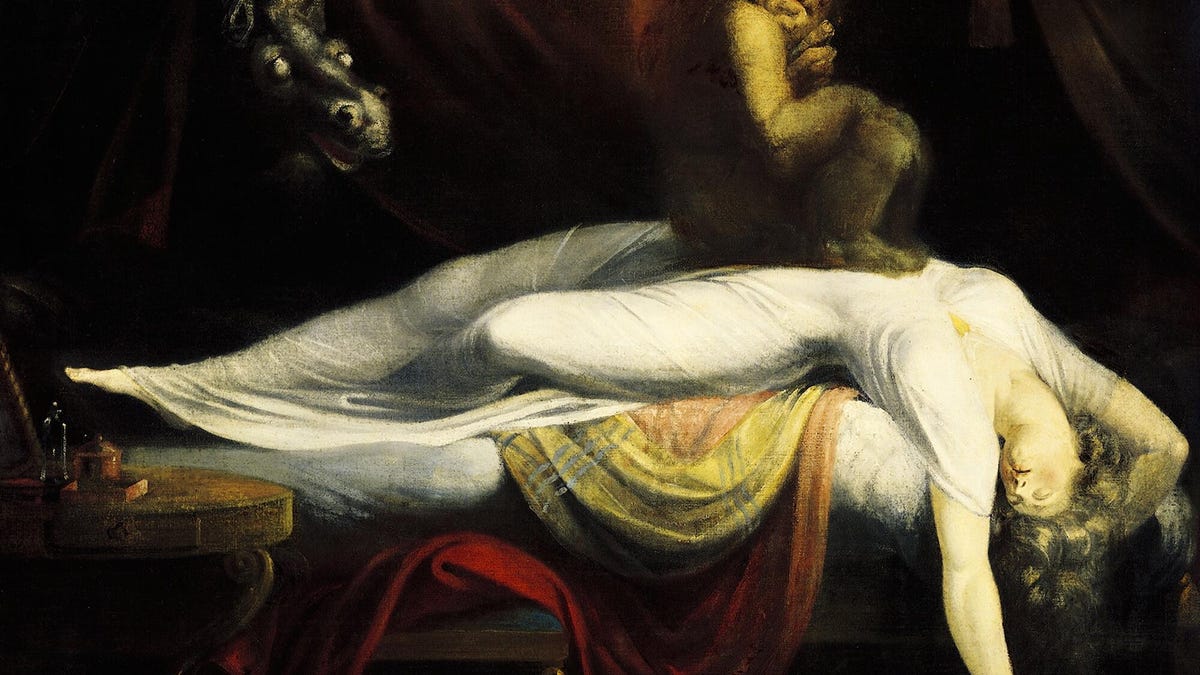Demons in your bedroom: What to know about sleep paralysis
Sleep experts describe sleep paralysis and how to overcome it.

The Nightmare by John Henry Fuseli depicts sleep paralysis, which some report feels like a demon sitting on your chest or a presence in your bedroom.
You're falling into a peaceful slumber; your body relaxes. Just as you're about to slip into sleep, you feel a dense pressure on your chest. It feels heavy, like an iron casket. You suddenly notice you can't move your arms when you try to shift the pressure on your chest. You can't move your legs either, you realize, as you try to wiggle away. Panic sets in.
That's what sleep paralysis often feels like, and it can be outright frightening, especially for people who have never experienced it before. Keep reading to learn more about what happens when the transition between dream sleep and wakefulness fragments.
Read more: What your dreams actually mean: Dream symbols, interpretation and causes
What is sleep paralysis?
Sleep paralysis is a temporary loss of muscle function that typically occurs as you're falling asleep, right after you fall asleep or as you're waking up.
"When sleep paralysis occurs, [often] right as you are waking up, you experience a brief loss of muscle control known as atonia," says Dr. Abhinav Singh, sleep physician, facility director of the Indiana Sleep Center and medical advisor to SleepFoundation.org. "You're trying to get into wake mode, but you'e somewhat still in your sleep mode," he says.
"You're coming out of dream sleep, with all that vivid imagery that accompanies it, yet you cannot move a limb or a muscle. You are sort of aware, but also transferring images from your dream into your reality now," Singh describes.
Research defines sleep paralysis as a "mixed state of consciousness, combining elements of rapid eye movement sleep with elements of wakefulness."
What does sleep paralysis feel like?
Many people describe feeling an ominous presence in the room.
Sleep paralysis is generally perceived as frightening, mainly due to the fact that it feels like a total loss of control, says Dr. Dave Rabin, neuroscientist and psychiatrist at Apollo Neuro, a neuroscience company. "This loss of control can make us feel helpless, which is an uncomfortable feeling," he says.
Many people experience panic-inducing hallucinations, Singh says, which usually fall into one of three categories:
- An intruder or dangerous person or presence in the room.
- Pressure, like someone is standing on your chest and you're being suffocated.
- Movement like flying, or being out of body or projected into space.
Put simply, "None of this is positive," Singh says.
It's normal to experience intense anxiety during sleep paralysis, but giving in to the anxiety can make it worse. Even if you don't have control of your body, you have control of your mind (you're conscious during sleep paralysis), so you have the power to remind yourself that what you're feeling is false.
How is sleep paralysis different from lucid dreaming?
People sometimes confuse lucid dreaming and sleep paralysis, because both conditions involve a half-awake, half-asleep state.
Sleep paralysis is unintentional and is a feeling of being conscious but unable to move, says Wayne Ross, senior sleep researcher at InsideBedroom. During sleep paralysis, your mind is awake but your body isn't.
Lucid dreaming, on the other hand, is often intentionally induced by people who want to gain control over their dreams. During a lucid dream, neither the brain nor body is fully awake, but dreamers regain just enough consciousness to become aware that they're dreaming.
In general, sleep paralysis is considered a negative and distressing experience while lucid dreaming is often (but not always) a positive experience.
How long do sleep paralysis episodes last?
Though it might seem like you're in sleep paralysis forever, it usually only lasts a couple of minutes.
It can feel like sleep paralysis lasts eons when you're in the grips of it, but in reality, sleep paralysis episodes generally only last a few minutes. This is also true of other sleep goings-on, including sleepwalking and night terrors.
Can sleep paralysis be treated?
If you struggle with sleep paralysis, here's some good news: You can reduce the likelihood of experiencing it. Dr. Frida Rångtel, sleep educator and science advisor at Sleep Cycle, says fixing sleep paralysis is mainly a matter of self-care. Here are some tips from Rångtel:
- Avoid sleeping on your back. Research shows that sleeping on the back can be linked to increased risk of sleep paralysis. Bulk up some pillow behind your back if you're prone to tipping over to your back while sleeping on your side.
- Keep bedtime consistent. Go to bed at the same time each night. While you're at it, try and keep a morning wake-up schedule as well. Keeping the same schedule for weekends and weekdays is most likely to reduce your risk of sleep paralysis. This way, your body gets used to it and your natural built-in body clock will do most of the work for you.
- Eliminate distractions in the bedroom. Don't watch TV in the bedroom and don't browse the web in bed. Keep lighting soft and try to block out loud noises.
- Decrease or fully stop your caffeine intake close to bedtime. Experiment to see how sensitive you are to caffeine and make adjustments accordingly.
Additionally, knowing the common causes of sleep paralysis can help you overcome it. According to Rabin, sleep paralysis is often caused by stress, alcohol and sleep deprivation, as well as sleep disorders such as narcolepsy and sleep apnea.
In such cases, treatment would include stress-management techniques such as deep breathing and meditation, reducing alcohol consumption before bed or in general, and prioritizing your quantity of sleep. "Find the cause of sleep paralysis, and work toward treating that," Rabin says.

